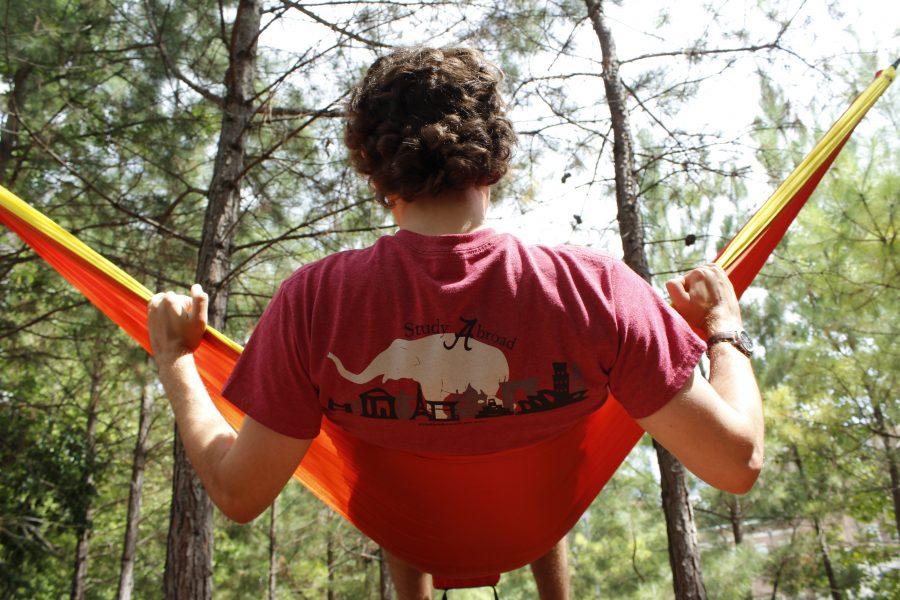Located off Veterans Memorial Parkway and University Boulevard, The University of Alabama arboretum offers 60 acres of hiking trails, gardens and even a couple greenhouses for students to explore in a mostly quiet getaway from campus life.
“It’s kind of a rest from all the concrete and asphalt everywhere, and except for when the train comes by, you can think you’re in a larger forest here,” said caretaker Joseph Wright. “It really kind of feels like you’re out in the woods sometimes. It’s a nice escape.”
Established in 1958, the arboretum is used for many educational purposes for students of all ages. It also serves as a “tree museum” as Monica Watkins, the arboretum director, put it. The park has many different types of trees, like poplar, pine and oak trees. One of those oak trees, a white oak, is the centerpiece of Watkins’ favorite part of the park – the tree platform.
Located about 40 to 50 feet in the air, the tree platform is a deck built into the side of one of the hills that lets visitors experience what it’s like to be up in the canopy of the forest.
“When I was a student, I would go out there and write my journal for class or do my homework or just sit out there and enjoy or draw,” Watkins said. “It’s so peaceful.”
Watkins worked at the arboretum as a trail guide back when she was enrolled at the University. Now she oversees the entire arboretum and not just as an administrator. Watkins “wears all the hats,” as she puts it, by helping out in the gardens, the greenhouses and giving tours for school groups that come visit.
“That’s really my passion – teaching people ecology,” she said. “What I really love to do is get people hands on outside taking their own measurements, trying to identify what type of plant is this.”
Introducing students to her favorite location in the arboretum, she said, makes her love the spot that much more.
“It’s the same kind of feelings they have about snakes,” Watkins said. “They have this mixture of fear and excitement and they get that way about the tree platform. For a lot of people that’s the only way they’re ever going to get to really experience being in the trees.”
Wright gets to spend time up in the trees. He sometimes climbs them to take care of any maintenance they may need. The only trees he hasn’t gotten to climb yet are the arboretum’s poplar trees, but he hopes to one day.
“It’s a different perspective up there,” Wright said. “Just having that kind of bird’s eye view of things changes your perspective. You get to see what the birds and squirrels see.”
The tree platform is also one of Wright’s favorite spots. He and his wife got married there last September. Wright grew up in Cottondale and said he’s been coming out to the arboretum for his whole life.
“Most of my family is decently outdoorsy, and my wife is decently outdoorsy and luckily she didn’t have a big dress or anything like that,” he said. “We were expecting some rain that day. We were going to have the wedding out here, come hell or high water, but luckily we just had a little bit of a drizzle earlier that day and then it was just perfect.”
Some of Wright’s favorite memories of the arboretum involve hiking the trails, which he said is a popular activity for students who come out to visit. He said that students who come out should be careful while hiking. While the staff takes great care to try and cut it back, poison ivy does grow along the trails, and there are some snakes around.
“I have yet to see a poisonous snake out here,” Wright said. “I have seen a number of non–poisonous ones. That’s not a concern for us, but we do check them out just to make sure they aren’t poisonous. But it’s always a possibility so people should just keep that in mind while they’re out. If they see a snake or other wild animal, don’t touch it. Enjoy looking at it but don’t interact with it. If you do see a snake, let us know so we can come and check it out and make sure it’s not poisonous.”
Both Wright and Watkins also said that while dogs are allowed onto the grounds, they are required to be on a leash, per Tuscaloosa law, and they ask that people clean up after their pets and keep an eye on them as there have been instances of dogs harassing wildlife or getting lost.
The arboretum also features garden space including a community garden and a children’s garden. There’s also a pond that’s home to frogs, turtles, fish and dragonflies. Watkins said that while the wildlife is beautiful, it’s there to be observed.
“We are a museum – please don’t pick anything,” she said. “Some things from the greenhouse we can give you a cutting from, but most things we have to respect that it’s kind of like a national forest – leave it intact, leave it the way that it is when you get here so that everyone can enjoy it.”
The one exception to this rule is the blueberry bushes near the community garden. But Watkins does have a rule for those: pick only what you can eat.
“Pick a handful or two and leave the rest,” she said. “If you come and pick them all there won’t be any for the little kid who comes an hour after you.”
The University of Alabama arboretum is open daily from 8 a.m. to sunset.







